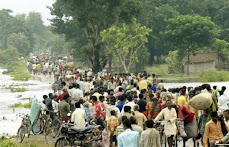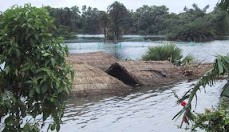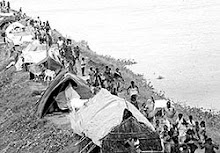Dropping bombs & reliefs
Hydraulic capitalism is taking its toll, while disaster & relief centric responses while essential are having a field day in the aftermath of the embankment breach of 18th August, 2008 that has inundated nearly 1,600 villages in 15 northern and central Bihar districts. It must be remembered the same state apparatus that caused the disaster and aggravated the calamity is having one believe that it is sincere in its relief responses.
Only the gullible will be taken for a ride by such propaganda. The situation is akin to dropping the bomb and subsequently dropping relief to the bomb victims as a humanitarian gesture.
The immediate sequence of events is quite revealing. State chief state engineer E Satyanarayan, stationed at Birpur near the Nepalese border where the Kosi river breached its embankments in August, had sent officials like Arun Kumar, responsible for Kosi project four desperate warnings between August 9 and 16, warning them against the imminent disaster, which went unanswered because the officer in question was on leave and no substitute for him was made available for decision making.
Eventually on August 16, with the situation worsening, the desperate engineer sent telegrams to 11 senior officials associated with flood water management in the state capital Patna. These were also ignored by callous IAS officers of the state. Two days later the Kosi flowed southward breached the embankment at the point Satyanarayan had identified as vulnerable.
Who is accountable for this criminal lapse? Who all were liable for the criminal interventions of the past? There were no answers and there will no answers. This "development nation-state" is infertile, it cannot deliver any.
Gopal Krishna
Passing the Buck-The Annual Saga of Floods in Bihar
Bihar is facing its annual floods. This is first year after a long time that the ruling combinations at the centre and at Patna are the same. That leads to a funny situation because the blame for floods cannot be passed on to the Centre which is what had been happening in the past. Centre, too, cannot say, at the moment, that it is the State subject and pass on the buck.
Since there is nobody available to pass the buck up on, the State Government accepts its helplessness in the matter that it cannot do anything but to reach relief to the people. The floods have created a situation of reciprocal inaccessibility.
The Government cannot reach the people and the people cannot reach the Government.
Quite often, one is told that the Government is helpless in such an extreme situation and what can it do to save the people? Let us see what the helpless Government could have done in that situation and failed to perform and want to get nation's sympathy.
Rashtriya Barh Ayog (National Commission on Floods-1980) had given 207 recommendations for improving the flood situation.
The government accepted 25 of them (in 1995) and did nothing to implement it.
Blame for floods and breaches in the embankment were first attributed to the holes dug by the rats in the body of the embankments. This hearsay story was ratified in 1968 by the Chief Engineer (Flood Control) of the Central Water Commission,
P.N. Kumra, when the Kosi embankment breached near Jamalpur in Darbhanga district in Bihar.
This was followed by passing the buck on to the 'anti-social elements' and then on to Nepal for releasing the floodwaters. This Nepal bogey is so wide spread and deeply entrenched in the minds of the people and media that even the news channels repeatedly announced that water has been released by Nepal. The other channels are no better either. There are only two control works in the form of barrages, one on the Kosi near Bhimnagar and the other at Valmikinagar on the Gandak.
Both these barrages are manned by the engineers of Water Resources Department (WRD) of Bihar Government who draw their salaries from the Government of Bihar and if any water is released, it is the handiwork of Bihar engineers with full knowledge of the
WRD Ministry at Patna and with their approval.
The Minister of WRD, Bihar Govt, denied the same that there is no such control and that Nepal could release the water.
Obviously Nepal cannot be blamed for this debacle. The politicians, however, either because of their ignorance or willfully, encouraged the Nepal canard to be spread and when the desired results were obtained, they issue mild denials now. Instead of
giving lame excuses in its defence, the Government should have evaluated its programmes that the investment in the flood control sector is doing more harm than good and should have taken the corrective measures long back.
For a long time, the people and the legislatures have been demanding that the job of flood control be entrusted to only one department but it is shared between WRD and Revenue Department, the latter being responsible for Maharaji and Zamindari
embankments. Since it is not inscribed on the embankments whether it is Maharaji, Zamindari, or the one belonging to the WRD; the passing the buck game is very skillfully played. It was in 1966 that a demand was made in Bihar Vidhan Sabha that the departments are merged so that the people know who they have to contact in case of emergency but it has not been conceded till date. What, other than lethargy and inefficiency, prevents the Government from adopting such simple measures that do not cost
Dinesh Kumar Mishra
Historically, floods and their control have never been a big issue in the Ganga-Brahmaputra basin, as it is today. Floods became a major issue after the British occupied India. When they examined the Ganga basin, they believed that if it could be made “flood-free”, they could levy a tax in return for such protection.
Friday, 5 September 2008
Subscribe to:
Post Comments (Atom)








No comments:
Post a Comment